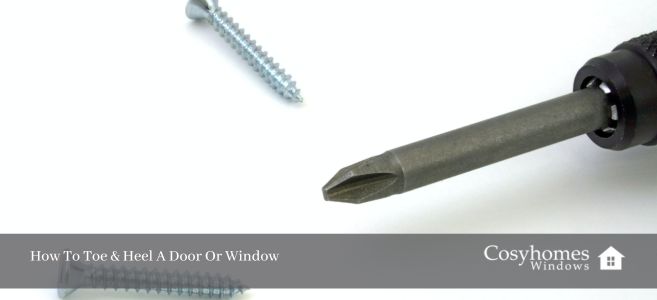A UPVC door is a high-quality door and will last for a long time. However, it’s normal for them to experience door-dropping after a period of time. Whilst one side of the door is supported on the hinge side, the lock side is not, and this is where wear and tear can occur.
A way to correct this drop is toe and heeling. This is a simple process that realigns the door and restores the correct and sustained operation of the door. This is important for energy efficiency and security.
Tools and Materials You’ll Need
To correctly toe and heel a door or window you will need:
- a tape measure
- stiff putty knives
- a glazing shovel
- packers or shims
- clear silicone
Step-by-Step Guide to Toe and Heel Adjustment
Here is a step-by-step guide to toe and heeling doors or windows:
1. Assess the Situation
Begin by giving the door or window a closer inspection. It might be difficult to lock or a window’s sash difficult to close fully because of a misalignment in the glass unit or frame.
Start by measuring the door diagonally – measure corner to corner (top left to right bottom corner, top right to left bottom corner). Make a note of each of the measurements and check if they match. If not, your door is out of alignment.
2. Remove the beading strips
First of all, remove the beading strips that hold any glass or panels to the door, start with the longer strips. To do this, place a stiff putty knife between the beading strip and the frame. Gently work the knife as a lever until the strip breaks away.
3. Remove the glass or panels
Next, remove any glass or panels from the door looking for any packers as you do so and removing them, before reinstalling the glass into the door frame. Position them as near to the lock side of the door as possible, leaving a slight gap on the hinge side. Then, take measurements of the distance between the glass or panel and the top of the frame, as well as the distance between the glass or panel and the hinged side of the frame. Record these measurements for reference.
Using the measurements you recorded in the previous step, take two packers that are half of the total width of the measurement (e.g. for a 6mm gap, packers need to be approximately 3mm). As well as two packers that are half of the total height measurement (from the glass or panel to the top of the frame). Next, position them within the frame.
4. Insert the glazing packers
Use the clear silicone to put one of the width-based plastic packers and one of the height-based packers into the bottom left corner of the frame. Each packer should be positioned around 50mm away from the corner, further along the longer door strip. These will help to distribute the pressure evenly and you can then add the glass or panel back into the frame
The glass or panel will naturally lean a little towards the lock side of the door, but don’t worry, this can be corrected by placing the glazing shovel into the lock side and pushing the glass or panel towards the hinge side of the door. Hold this in place by adding another width-based packer to the top right corner of the frame 50mm down from the corner.
Now you will need to use the glazing shovel on the top of the lock side of the door, and work it gently to lift the frame into place, before adding the second height-based packer to the top right corner of the frame – 50mm left of the corner.
5. Test and fine-tune
Once all of your packers are in place, you will then need to check that the frame and door panels are level with each other. Then test whether the door is able to open, close and lock properly, before refitting the beading strips. If you think the door may need a re-fit, or is still not in the correct position, contact a professional for advice.
Conclusion
We hope that this article has been useful in giving you some guidance into toeing and heeling doors, if you decide to have a go yourself. If you don’t feel confident to toe and heel yourself, we’re here to help. Contact Cosyhomes Windows for help and advice.


















No Response to "How To Toe & Heel A Door Or Window"